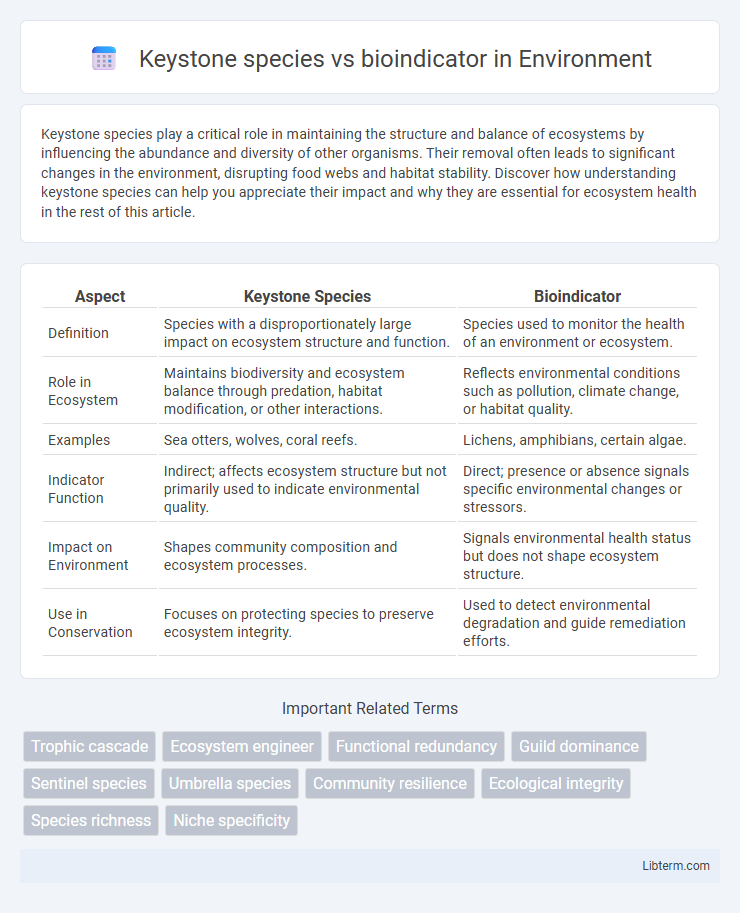Keystone species play a critical role in maintaining the structure and balance of ecosystems by influencing the abundance and diversity of other organisms. Their removal often leads to significant changes in the environment, disrupting food webs and habitat stability. Discover how understanding keystone species can help you appreciate their impact and why they are essential for ecosystem health in the rest of this article.
Table of Comparison
| Aspect | Keystone Species | Bioindicator |
|---|---|---|
| Definition | Species with a disproportionately large impact on ecosystem structure and function. | Species used to monitor the health of an environment or ecosystem. |
| Role in Ecosystem | Maintains biodiversity and ecosystem balance through predation, habitat modification, or other interactions. | Reflects environmental conditions such as pollution, climate change, or habitat quality. |
| Examples | Sea otters, wolves, coral reefs. | Lichens, amphibians, certain algae. |
| Indicator Function | Indirect; affects ecosystem structure but not primarily used to indicate environmental quality. | Direct; presence or absence signals specific environmental changes or stressors. |
| Impact on Environment | Shapes community composition and ecosystem processes. | Signals environmental health status but does not shape ecosystem structure. |
| Use in Conservation | Focuses on protecting species to preserve ecosystem integrity. | Used to detect environmental degradation and guide remediation efforts. |
Introduction to Keystone Species and Bioindicators
Keystone species play a critical role in maintaining the structure and function of an ecosystem, often exerting influence disproportionate to their abundance, such as sea otters controlling sea urchin populations to protect kelp forests. Bioindicators, on the other hand, are species or biological responses that provide information on the health and quality of the environment, exemplified by lichens' sensitivity to air pollution indicating atmospheric conditions. Understanding both keystone species and bioindicators is essential for ecosystem management and conservation, as they reveal the intricate connections within habitats and early signs of environmental change.
Defining Keystone Species
Keystone species are organisms that have a disproportionately large impact on their ecosystems relative to their abundance, playing a critical role in maintaining ecological balance and biodiversity. Unlike bioindicators, which provide information about the health of an environment through their presence or absence, keystone species actively shape the structure and function of their habitats. Examples include sea otters controlling sea urchin populations and wolves regulating prey species, illustrating their fundamental influence on ecosystem stability.
Understanding Bioindicators
Bioindicators are organisms or biological responses that reveal the health of an ecosystem by signaling changes in environmental conditions, often used to detect pollution or habitat degradation. Unlike keystone species, which exert a disproportionate influence on ecosystem structure, bioindicators provide measurable data on ecological quality and stressors without necessarily shaping the ecosystem's fundamental dynamics. Monitoring bioindicators such as lichen diversity or amphibian populations enables precise assessment of habitat integrity and early warning of ecosystem disturbances.
Key Differences Between Keystone Species and Bioindicators
Keystone species play a crucial role in maintaining the structure and stability of an ecosystem by influencing the presence and abundance of other species, while bioindicators serve as measurable indicators of environmental health or pollution levels. Keystone species impact ecosystem dynamics through their biological interactions, whereas bioindicators provide scientific data on ecosystem conditions by reflecting changes in environmental quality. Understanding these distinctions is essential for effective conservation strategies and environmental monitoring.
Ecological Roles and Functions
Keystone species play a critical role in maintaining the structure and balance of ecosystems by influencing population dynamics and resource availability, often regulating biodiversity through trophic cascades. Bioindicators serve as measurable biological responses to environmental changes, providing insights into ecosystem health and the presence of pollutants or habitat degradation. While keystone species actively shape ecological communities, bioindicators primarily act as diagnostic tools for monitoring ecosystem integrity.
Examples of Keystone Species in Various Ecosystems
Sea otters in kelp forests control sea urchin populations, preserving underwater vegetation essential for marine biodiversity. African elephants in savannas maintain grassland ecosystems by uprooting trees, supporting a variety of herbivores and predators. Coral species in reef ecosystems create complex habitats, enabling diverse marine life to flourish and indicating overall reef health.
Common Bioindicator Species and Their Significance
Common bioindicator species such as lichens, amphibians, and freshwater macroinvertebrates provide essential insights into environmental health by reflecting changes in air and water quality, habitat conditions, and ecosystem stability. Unlike keystone species that maintain ecological balance through their functional roles, bioindicators serve as sensitive markers that signal pollution levels, habitat degradation, and biodiversity shifts, enabling early detection of environmental stressors. Their significance lies in guiding conservation efforts, environmental monitoring, and policy decisions by providing quantifiable data on ecosystem integrity and anthropogenic impacts.
Importance in Environmental Monitoring and Conservation
Keystone species play a critical role in maintaining the structure and stability of ecosystems by influencing biodiversity and trophic interactions, making their presence essential for ecosystem integrity. Bioindicators, on the other hand, provide valuable data on environmental quality and ecosystem health through their sensitivity to pollutants and habitat changes. Monitoring keystone species and bioindicators together enhances conservation efforts by enabling early detection of ecological disturbances and guiding targeted management strategies.
Challenges in Identifying Keystone Species and Bioindicators
Identifying keystone species poses challenges due to their complex ecological roles that may vary across ecosystems and the subtle influence they exert on biodiversity and trophic structures. Bioindicators face difficulties in selection because their responses can be affected by multiple environmental factors, complicating the attribution of changes to specific pollutants or stressors. Both require extensive, long-term ecological data and precise monitoring to accurately assess their status and the health of ecosystems.
Future Perspectives in Ecosystem Management
Keystone species play a critical role in maintaining ecosystem structure and function, making their preservation essential for future ecosystem management strategies focused on resilience and stability. Bioindicators provide valuable data on environmental changes and pollution levels, enabling early detection of ecosystem health shifts and informing adaptive management practices. Integrating keystone species protection with bioindicator monitoring enhances proactive decision-making and supports sustainable biodiversity conservation in dynamic ecosystems.
Keystone species Infographic

 libterm.com
libterm.com